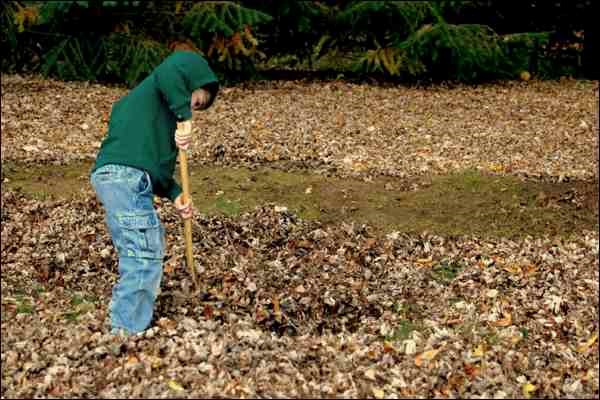My mother, without the benefit of the Internet, Netflix, tablet computers or the now ubiquitous smarter-than-me phone - had to be inventive in keeping us kids occupied. So in the fall, out came the blank paper, crayons and a few gathered leaves. We put the leaves under the paper and coloured the whole sheet with random crayons, revealing the leaf shapes and intricate vein patterns in a panoply of colour, ending up with "art" for the fridge. Of course the other fun thing to do with leaves is to jump into large piles of them, partially undoing the hard work of raking them up.
For us adult, our job is to remove the leaves from the lawn so they don't become a sodden mass, smothering and killing the grass over winter. You can use a traditional leaf rake to corral them into loose piles or a leaf-blower to herd them into place. Alternatively, use your power mower to shred and bag them up. Raising the front of the mower one or two settings improves the vacuum simulation. The advantages of shredding the leaves are reducing the amount of space they occupy and speeding up their eventual breakdown.
The next step is figuring out what to do with your leaves. Rotilled directly into the garden, leaves add organic matter, improve tilth (ease of cultivation) and increase water-holding capacity. Leaves also add significant amounts of nitrogen, phosphorous, potassium, sulphur, boron and other essential nutrients. A six-inch deep leaf layer is a reasonable amount to incorporate into your garden. Because the nutrients tied up in leaves are not immediately available for plant growth in the year following fall application, you should amend the soil with additional organic or synthetic fertilizer to optimize growth.
Do not add a thick layer of shredded or whole leaves to your perennial beds. Over winter, the leaves do not have enough time to break down to any extent and will instead become a wet, impermeable barrier to spring growth. Tree and shrub beds are a quite different story and a layer of leaves there acts as an excellent mulch, keeping the soil cool and moist in the summer and preventing weed seeds in the soil below from germinating.
Leaves are of course compostable. You can compost them alone in a wire bin, turning the pile occasionally to produce leaf mold, a much sought after fungus-rich compost that has excellent water holding capacity when added to soil. This process can take up to two years. Or you can use leaves as a component in a well-balanced compost pile, layered with other carbon (e.g. non-glossy paper, straw, wood chips) and nitrogen sources (e.g. grass clippings, uncooked fruit and vegetable scraps, egg shells, coffee grounds). Add a few shovels full of soil to add the microbes that do the hard work of breaking down the organics. During the growing season, turn the pile monthly to aerate and keep it moist but never soggy. Adding compost starter or a small amount of high nitrogen fertilizer gets the pile cooking sooner but is not essential. If all goes right, you should have fully rotted compost by fall, ready to add to the garden before the snow falls.
If you don't have a compost pile or don't have the time or space to start one, you can drop off your bags of leaves (and other garden waste) for free at one of two compost depots in Saskatoon (McOrmond Drive, approx. 0.8 km north of 8th Street and Highway 7 at 11th Street junction). The depots are open daily until Nov. 8. For more information about Saskatoon's compost facilities: www.saskatoon.ca, select 'C' in the 'Browse A-Z Listings' feature, then scroll down to 'Composting'. Or phone 306-975-2487.
- This column is provided courtesy of the Saskatchewan Perennial Society (www.saskperennial.ca; [email protected]).
Upcoming events:
Oct. 23 - Made in Saskatchewan - Sour cherries, Haskaps and other introductions from the University of Saskatchewan. Presented by Bob Bors (www.fruit.usask.ca), U of S Fruit Specialist. 7:30 - 9:30 p.m., St. James Anglican Church, 607 Dufferin Ave., Saskatoon.




